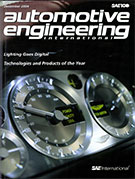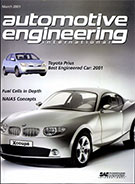Magazine

Automotive Engineering International 2001-02-01
2001-02-01
Next-generation adaptive cruise control Deceleration capabilities, along with a wider operating speed range, are some of the enhancements of Delphi's newest system. All-plastic manual-clutch actuation Engineers at Automotive Products are developing the relatively new material application for improved economy, smaller engine components, and new vehicle concepts such as hybrids. ...Mueller, Chairperson of the SAE 2001 World Congress, who came up with "Succeeding in the Alliance Game" as the theme for the March 5-8 automotive engineering event in Detroit. Ferrari 360 aerodynamic development The search for downforce without aerodyamic devices, such as wings or spoilers, led to novel solutions for the car's suspension. ...AEI Tech 2001 Awards Automotive Engineering International's editors highlight the top products and technologies to be on display at the SAE 2001 World Congress.




